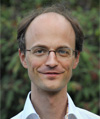will take place on Tuesday, January 24, 2017 from 17:15 to 18:15 hours in CBBM, EG, Room 50/51.
Host: Prof. Markus Schwaninger
Institute of Experimental and Clinical Pharmacology and Toxicology
University of Lübeck
Objectives
Post-stroke angiogenesis after transient middle cerebral artery occlusion correlates with functional recovery in both mice and man. On the molecular level, angiogenesis is triggered by tissue hypoxia and inflammation in the peri-infarct tissue. We aimed to answer the research question whether post-stroke angiogenesis depends on endothelial Stat3 signaling and whether there is a causal link between post-stroke angiogenesis and changes in the microenvironment that foster neuroplasticity.
Material and Methods
We studied 8-12 week old conditional Stat3 knockout mice that were restricted to endothelia by crossbreeding Tie2-CreERT2:Stat3floxed KO mice. Stat3 loss was achieved by tamoxifen injection 7 to 2 days prior 30 min of middle cerebral artery occlusion and outcome measures were performed as indicated in the experimental design.
Results
The outcome was neutral for stroke volume in the short-term but angiogenesis was decreased in endothelial specific knockout mice. This was reflected by changes in the transcriptomes. Both IL6 constitutive knockout animals as well as endothelial specific ablation of signal transducer of activator of transcription 3 (Stat3) show blunted angiogenic profiles. Mice showed worth functional outcome as measured by Rota Rod and extended Neuroscores and increased lesion volume in the long-term (28 days of survival). Scar formation and matrix composition differed between both genotypes resulting in an microenvironment that does not favor axonal growth promoting transcriptional patterns as measured by gene arrays from the vascular niche.
Conclusion
Angiogenesis correlates with favorable outcome. Since post-stroke angiogenesis is initiated too late to protect neurons, effects of repair and neuroplasticity after stroke might be the molecular substrate of superior recovery in animals with increased angiogenesis. Here, we try to figure out the effects of disturbed angiogenic responses on the microenvironment including extracellular matrix changes that might be key for recovery after focal cerebral ischemia in mice. We aim to provide a causal link between angiogenesis and neuroplasticity as a non-cell autonomous mechanism of stroke recovery in the long-term.
Biosketch
Christoph Harms, MD (born in 1973) is currently a tenured Assoc. Prof. of Molecular Stroke Research at the Center for Stroke Research, Department of Experimental Neurology at Charité-Universitätsmedizin Berlin, Germany. The research of Christoph Harms focuses on stroke research, brain imaging and molecular treatment of stroke. He is particularly interested on how the brain protects itself (‘endogenous neuroprotection’) and how plasticity of the brain might be increased to foster repair and functional recovery after stroke. Longitudinal imaging of the brain and its dynamic changes of molecular patterns along with in-depth behavioral characterization of animal models of stroke allow to understand changes and consequences of connectivity, blood flow, post-stroke angiogenesis, extracellular matrix composition and neuro-glial interactions. These lesion-symptom maps provide insights into the impact of intercellular and intracellular signaling after stroke injury that is modulated using custom-made transgenic animal models or proof-of-principle pharmacological treatment e.g. by TAT-protein transduction or viral methods. In order to improve the predictiveness of translation of preclinical research into clinical testing, a systematic quality management system within the Department of Experimental Neurology has been established.


